The following is a summary of global temperature conditions in Berkeley Earth’s analysis of August 2023.
- Globally, August 2023 was the warmest August since records began in 1850.
- The previous record for warmest August was broken by a large margin.
- Both land and ocean individually also set new records for the warmest August.
- The combined effect of global warming and a strengthening El Niño primarily helped to produce this record, but were likely also aided by additional warmth from other factors discussed below.
- Particularly warm conditions occurred in the North Atlantic, Eastern Equatorial Pacific, Northern South America, Central America, parts of Africa and the Middle East, Japan, and parts of India.
- Unusually cool conditions were present in parts of Antarctica.
- The North Atlantic is experiencing all-time record warmth by a large margin.
- El Niño continues to strengthen and is expected to continue into next year.
- 2023 is now virtually certain to become a new record warm year (>99% chance).
Global Summary
Globally, August 2023 was the warmest August since directly measured instrumental records began in 1850, breaking the record previously set in August 2016. In addition, this August exceeded the previous record by 0.31 °C (0.56 °F), a surprisingly large margin, well outside the margin of uncertainty.

The global mean temperature in August 2023 was 1.68 ± 0.09 °C (3.02 ± 0.16 °F) above the 1850 to 1900 average, which is frequently used as a benchmark for the preindustrial period.
This is the 12th time in the Berkeley Earth analysis that any individual month has reached at least 1.5 °C (2.7 °F) over the preindustrial benchmark. However, July and August 2023 are the only times, thus far, that a 1.5 °C anomaly has occurred during Northern Hemisphere summer. Such a temperature excess coming during already hot summer months is more likely to lead to extreme temperatures and all-time records than if it had occurred at other times of the year.
One of the Paris Agreement ambitions has been to limit global warming to no more than 1.5 °C (2.7 °F) above the preindustrial baseline. That goal is defined in reference to the average climate over many years, so a few individual months above 1.5 °C do not automatically mean that the target has been exceeded. However, isolated anomalies above 1.5 °C are a sign that the Earth is getting close to that limit. It is likely that global warming will cause the long-term average to exceed 1.5 °C during the 2030s unless significant reductions in greenhouse gas emissions are achieved soon.
The last three months have been extraordinary in terms of global average temperatures, with new monthly records set every month and often by a large margin.
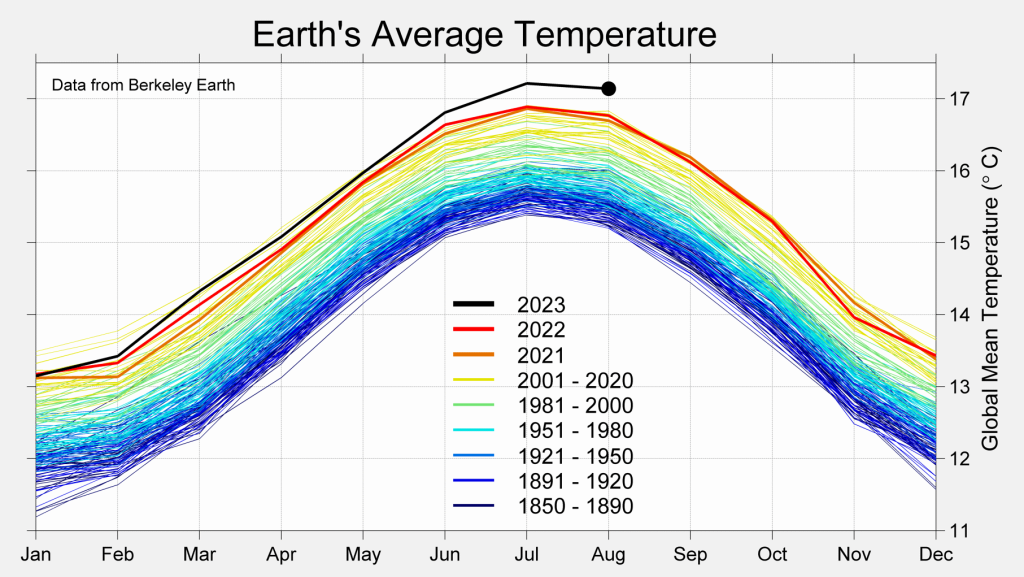
The global mean temperature anomaly in August 2023 exhibited a moderate increase relative to July 2023, rising 0.08 °C (0.14 °F). Such an increase is unsurprising during the strengthening phase of a new El Niño event.
Within the uncertainty margin, the monthly temperature anomaly in August 2023 effectively tied February and March 2016 for the largest single-month temperature anomaly on record.
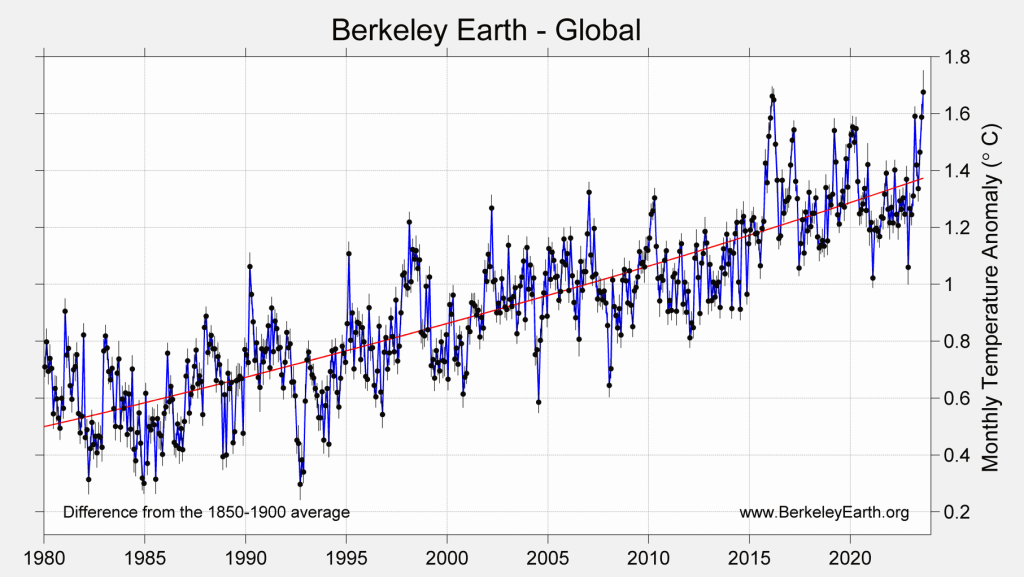
Spatial Variation
August 2023 continues the ongoing pattern of widespread warmth, though with a few exceptions. Particularly warm conditions were present in the North Atlantic, Eastern Equatorial Pacific, Northern South America, Central America, parts of Africa and the Middle East, Japan, and parts of India.
Particularly cool conditions were present in parts of Antarctica.
We estimate that 13.0% of the Earth’s surface experienced their locally warmest August average, and 87% of the Earth’s surface was significantly warm when compared to their local average during the period 1951 to 1980. In addition, none of the Earth’s surface had their locally coldest August, though parts of Antarctica had their 2nd or 3rd coldest August.
The Equatorial Pacific in August is showing strengthening El Niño conditions. Above average temperatures are present in much of the Pacific, with record warm temperatures for this time of year developing in some areas of the Eastern Equatorial Pacific. An El Niño condition was officially declared by NOAA in early June.


Over land regions, 2023 was also the warmest August ever observed, and warmed modestly relative to July. The land average was 2.27 ± 0.18 °C (4.08 ± 0.32 °F) above the 1850 to 1900 average. This beats the previous record for August, which was held by 2016.

In total, we estimate that 65 countries (mostly in the tropics) had their warmest August on record, these were:
Antigua and Barbuda, Bahrain, Barbados, Bolivia, Brazil, Burundi, Cabo Verde, Cambodia, Cameroon, Central African Republic, Chad, China, Colombia, Comoros, Cuba, Democratic Republic of the Congo, Djibouti, Dominica, Dominican Republic, Ecuador, Eritrea, Ethiopia, Gabon, Grenada, Guatemala, Guinea, Guyana, Haiti, Iran, Iraq, Ivory Coast, Jamaica, Japan, Kenya, Liberia, Mauritania, Mauritius, Mexico, Morocco, Niger, Palau, Panama, Peru, Philippines, Qatar, Republic of the Congo, Russia, Rwanda, Saint Kitts and Nevis, Saint Lucia, Saint Vincent and the Grenadines, Samoa, Saudi Arabia, Seychelles, Somalia, Sri Lanka, Sudan, Suriname, Tanzania, The Bahamas, Trinidad and Tobago, Turkey, Venezuela, Western Sahara, and Yemen
In addition, some of these broke their August records by extraordinary margins. In Ecuador, close to the strengthening El Niño, the August average temperature record was broken by more than 1.4 °C (2.5 °F).

August 2023 was also the warmest August in the oceans, recorded as 1.26 ± 0.11 °C (2.27 ± 0.19 °F) above the 1850 to 1900 average. This beats the previous record for August, which occurred in 2020, by a large margin.
The ocean temperature anomaly for August is largely unchanged from July, which was — by far — the largest ocean-average temperature anomaly observed in instrumental measurements for any month of the year.


Last Three Months
The last three months, June to August, are the summer months in the Northern Hemisphere. 2023 had by far the warmest such period on record globally, with each month setting a new monthly record. This was heavily influenced by the strengthening El Niño, record warmth in many parts of the Tropics, and the extraordinary warmth in the Northern Hemisphere Atlantic. Other places, such as most of Europe and most of the United States, had above average temperatures during summer but did not experience one of their warmest summers on record.


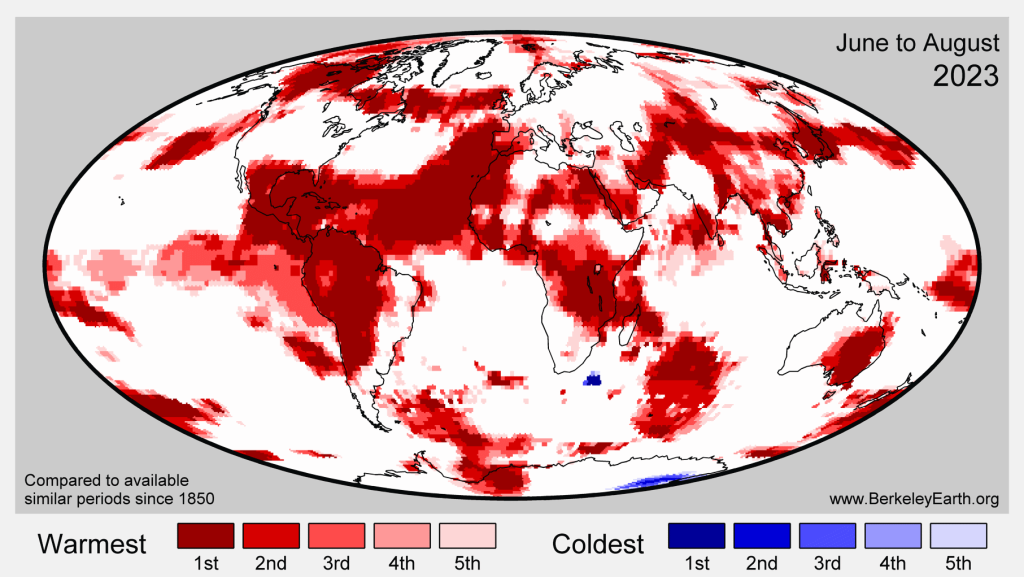
Causes of Recent Warmth
This month’s record, and the longer recent period of warmth, are driven by a combination of several man-made and natural factors acting together.
Firstly, man-made global warming has been raising the Earth’s temperature by about 0.19 °C/decade (0.34 °F/decade). This is a direct consequence of the accumulation of additional greenhouse gases in the atmosphere, especially carbon dioxide. This is the primary factor responsible for long-term warming.
However, global warming is a gradual process. It does not explain short-term spikes and fluctuations in Earth’s average temperature. The main reason for such spikes is internal variability in the distribution of heat and circulation of the oceans and atmosphere. The largest and most well-known form of short-term internal variability is the El Niño / La Niña cycle originating in the Pacific. During the El Niño phase, global average temperatures tend to be slightly higher. As a result, record highs for global average temperature tend to be set during El Niño years. This year, a new El Niño officially began in June after a multiple year period of La Niña.
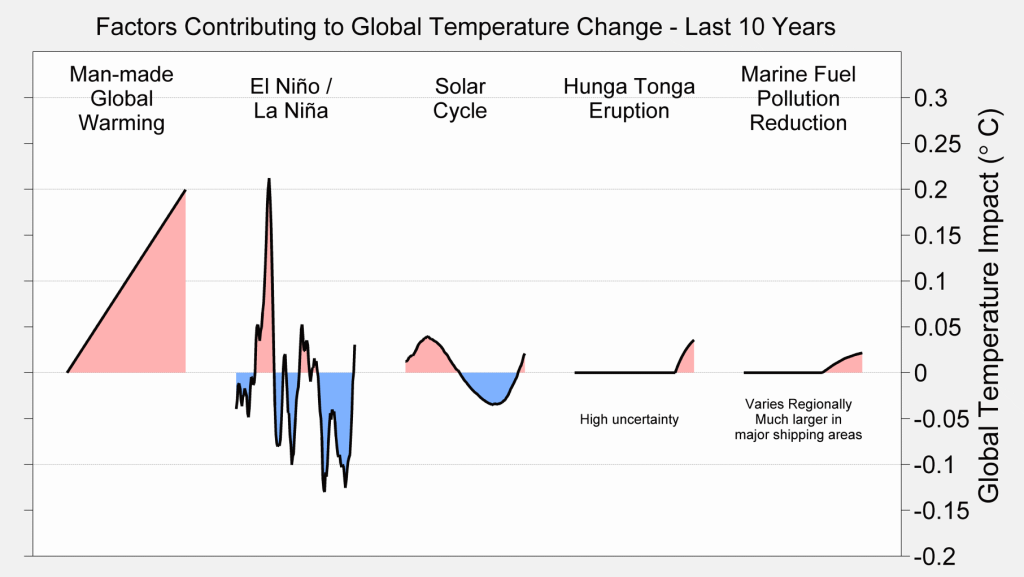
These two factors, global warming and El Niño, are the primary factors responsible for the present high temperatures. However, three additional factors are worth highlighting.
Firstly, the solar activity cycle is still ramping up towards a peak in 2024 or 2025. Such cycles are a natural part of the dynamics of the sun and follow an ~11-year pattern. During the active phase, the associated modest increase in solar radiation can lead to slightly warmer conditions.
Further, the massive eruption of Hunga Tonga–Hunga Haʻapai in January 2022 may be contributing to current warming and other weather effects. Unlike most volcanoes, the eruption of Hunga Tonga was rich in water vapor and low in sulfur. Usually, a large eruption results in a temporary period of cooling due to excess sulfur in the atmosphere, but the Hunga Tonga eruption may have contributed warming instead due to its large water vapor contribution.
Hunga Tonga injected ~150 million tonnes of water vapor into the stratosphere. This is small compared to the atmosphere’s total water vapor content, but unusually large for the stratosphere. This eruption raised the water vapor content of the upper atmosphere by ~15%. This plume, which will take at least several years to dissipate, has been estimated by Jenkins et al. to warm the Earth by about +0.035 °C (0.063 °F). However, the magnitude of warming remains highly uncertain as does the possibility of more impactful regional variations.

Lastly, in 2020, the International Maritime Organization adopted new rules on the allowable sulfur content in marine fuels. These new rules had the effect of cutting the sulfur emissions from marine shipping by ~85% almost overnight. Because sulfur aerosols have short-lived cooling effect, the removal of these aerosols likely warmed regions with heavy shipping activity. This was discussed in the previous report, and is discussed further in the next section on the North Atlantic. For the global average, the effect of removing marine aerosols may have added about 0.02 °C (0.03 °F).
While the primary drivers of recent temperature change are global warming and El Niño, those additional factors may also be acting in concert to add a bit more warmth to the global average temperature and create the present record warm conditions.
North Atlantic
The North Atlantic Ocean has been record warm in June, July, and August 2023, beating the previous record from these months by a very large margin (more than 0.5 °C/0.9 °F), and contributing substantially to the record global averages over the last three months. The present anomaly developed rapidly, increasing more than 0.35 °C (0.6 °F) since May, and is highly unusual.

We believe that the warmth in North Atlantic is due to a combination of extreme internal variability and man-made factors. On the internal side, we have the early stages of El Niño, the low Saharan dust discussed in June, and an unusual high pressure system in the northwest portion of the North Atlantic in July. The man-made factors include global warming, but also the recent reduction in marine sulfur pollution.
As discussed in July, new international rules governing heavy fuels for marine shipping abruptly reduced sulfur emissions from large ships by ~85% in 2020. This change was made to preserve human health, due to the toxic nature of sulfur aerosols. However, such aerosols also reflect sunlight, and as a result have a cooling effect. These sulfur aerosols are believed to have masked some of the effects of global warming, especially in the heavily trafficked North Pacific and North Atlantic regions. Because marine aerosols are short-lived, there impact is largest close to where they are released, including areas with large numbers of cargo ships, such as the North Atlantic. An analysis suggests that removing the sulfur aerosols may have added ~0.25 °C (~0.5 °F) to the North Atlantic region.
Marine sulfur reduction would not explain all of the present North Atlantic spike, but may have added to its severity. The current North Atlantic temperature anomaly is extremely far from the trend line. If attributed to natural causes alone, such an anomaly would be quite rare (e.g. once in a 100 years or less). However, if we assume that approximately 1/3 of that warming was due to the recent reduction of marine sulfur emissions, then the remaining warming spike would be consistent with a large — but not extreme — natural variation from the trend. We consider it plausible that the current extreme North Atlantic warmth is due to a combination of large natural variability (contributing about 2/3) and the man-made reduction in marine sulfur pollution (contributing about 1/3).
The reduction in marine sulfur aerosols from shipping, though regionally significant in areas with high shipping volumes, has likely only added a few hundredths of a degree to the global average temperature.
Antarctica
Another feature of the temperature distribution in August 2023 was unseasonably warm conditions around the periphery of Antarctica. Though Antarctica remains well-below freezing, and has been in the middle of Southern Hemisphere winter, the sea ice around Antarctica is refreezing far more slowly than in any previously observed year in the satellite record (starting in 1979), running roughly a month behind the typical schedule.
It is unclear to what extent the unusual evolution of Antarctic sea ice this year may be related to climate change or to other unusual factors such as the Hunga Tonga eruption.

El Niño Outlook
August 2023 saw the strengthening of the new El Niño that began in June. The current CPC/IRI analysis suggests that El Niño conditions will persist for the foreseeable future, at least until next year. Models currently disagree on the likely intensity of the current El Niño, with some models predicting a very strong event, while others are more moderate. The intensifying warm pool in the Pacific will likely give us a clearer idea of what to expect during the next month or two.
El Niño is likely to moderately boost global average temperatures during the rest of 2023 and into 2024. Due to the lag between the development of El Niño and its full impact being felt on global temperatures, it is likely that the current El Niño will have a greater impact on global temperatures in 2024 than it does in 2023. If other factors remain warm, such as the North Atlantic, that raises the possibility that the annual average in 2024 could be even warmer than 2023.


Year to Date
This year began with a January that was similar to January in 2021 and 2022. However, with the end of La Niña, temperatures diverged markedly in February and March, and are now far warmer than in 2021 or 2022. With the development of El Niño and record warmth in the North Atlantic, July and August continued to warm to unprecedented levels.
June, July, and August set new records for monthly average temperature in 2023, and by large margins. As discussed below, we consider it nearly certain that 2023 will set a new record for the warmest annual average.

The most significant spatial features of year-to-date temperatures are the shift towards El Niño, warmth across much of the northern mid-latitudes, cooling in the Western USA, and several ocean hotspots (especially the North Atlantic). Year-to-date, 8.6% of the Earth’s surface has experienced average temperatures that are a local record high. In addition, none of the Earth’s surface has been record cold year-to-date.

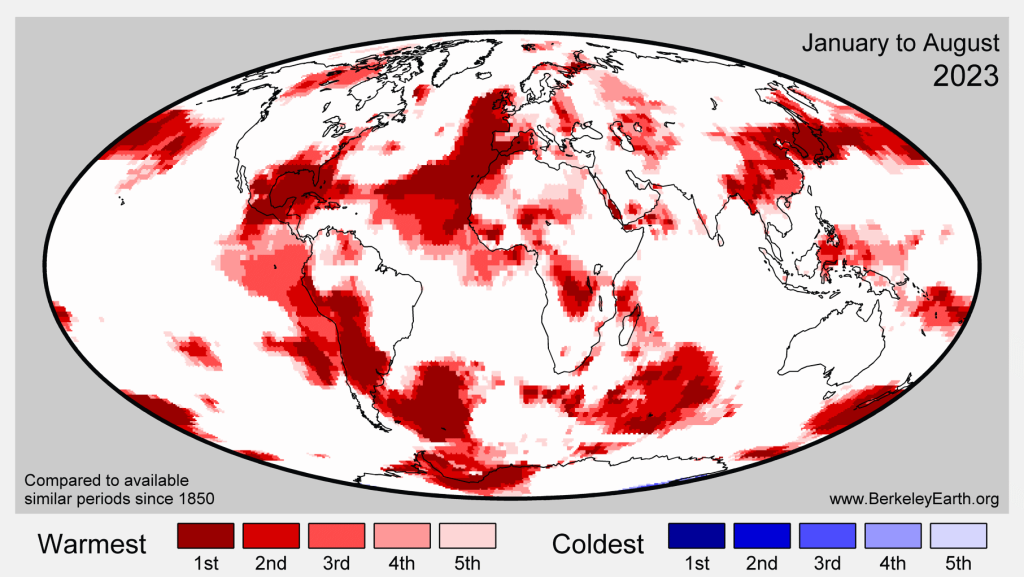
Rest of 2023
2023 is on pace to be the warmest year yet observed since instrumental measurements began. The surprisingly strong warming in June, July and August 2023, combined with the likelihood of a strong El Niño event, have increased the forecast for the rest of 2023. The statistical approach that we use, looking at conditions in recent months, now believes that 2023 is virtually certain to become the warmest year on record (>99% chance).
This forecast probability is essentially unchanged from last month’s report, where we also forecast a 99% chance of an annual record. However, it represents a large change from the forecast at the beginning of the year (before the development of El Niño), when only a 14% chance of a record warm 2023 was estimated.
In this assessment, we also find it nearly certain that 2023 will result in the warmest ocean-average year ever measured (>99% likelihood), boosted by global warming and the presence of El Niño.
However, it remains unclear if the land average will set an annual average record in 2023. Currently, we forecast a 60% chance of a new land-average record in 2023, an significant increase from last month when a land-average record was still considered moderately unlikely.
The surprising recent warmth and the potential for a strong El Niño, has continued to raise our estimates for the final 2023 annual average. We now consider there to be a 55% chance that 2023 has an annual-average temperature anomaly more than 1.5 °C/2.7 °F above the 1850-1900 average. This is a sharp increase from last month’s report, when only a 20% chance of a 1.5 °C anomaly was forecast. Prior to the start of 2023, the likelihood of a 1.5 °C annual average this year was estimated at <1%. The fact that this forecast has shifted so greatly serves to underscore the extraordinarily progression of the last few months, whose warmth has far exceeded expectations.
[Note: These predictions are based on the statistical relationships observed in past years. Given the highly unusual conditions currently present in the North Atlantic and elsewhere, these predictions may be less accurate than we’d typically expect.]
Because of the lag between the development of an El Niño and its maximum impact on global temperatures, an El Niño during 2023 may have an even larger warming effect on global mean temperature in 2024 than 2023. It is common for the second year of an El Niño to be warmer than the first year. Whether that ultimately holds true in 2024 may still depend on other factors, such as whether the North Atlantic also remains very warm or settles to a more normal temperature during 2024.

Likelihood of final 2023 ranking:
- 1st place (>99 %)

